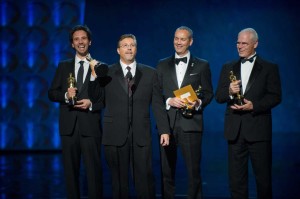
The frenetic online dialogue has been ratcheting up in the wake of the troubles at R&H, especially with the convergence of events on Oscar night – the street protest by VFX workers at the Oscars; Bill Westenhofer being drowned out by the Jaws theme as he steered his Oscar speech toward the R&H situation, to Ang Lee’s omission of that same situation during his own statue acceptance.
Tippet’s tweet, on a post-Oscar night when charges and alarms were flying quickly and thickly, linked to a longer declaration, where he said that history was repeating itself as it had with the garment and auto industries, “thanks to engines driven by corporate greed, no one can blame anyone” for chasing better deals, “but has anyone really acknowledged the historical past that has been given away? Hollywood, our last great homegrown export is going the way of the dinosaur, nuked not by a rock from space but by studios… insisting producers take work to subsidized territories, thus forsaking those of us in California who reinvented what we now call visual effects.” Presumably the dinosaur he refers to won’t be rendered anywhere in town, then.

Yet in the damned-if-you-do or damned-if-you-don’t way that marks any highly outsourced industry in an age of economic precariousness, VES also found itself the subject of much Twitter scorn, as across-the-border workers feel that the group is outing itself as a “California first” organization, rather than a global one.
“When you’re looking at other geographical regions in the world, no one is hurting as bad as California is,” according to VES chair Jeff Okun. “We’re in horrible shape… Everyone is moving out. We’re in a triage situation. The first thing you do is keep the patient alive long enough to cure them.”
 This doesn’t mean patients elsewhere need start ailing: “I don’t believe all the work will come back to California,” he said, even if the situation could be adequately addressed in the short term. And it doesn’t mean that “London will go bankrupt, or that Sydney will go bankrupt.”
This doesn’t mean patients elsewhere need start ailing: “I don’t believe all the work will come back to California,” he said, even if the situation could be adequately addressed in the short term. And it doesn’t mean that “London will go bankrupt, or that Sydney will go bankrupt.”
He acknowledges that with the heated rhetoric, things are a little messy right now. “We’re running in circles, we’re attacking each other.”
Okun noted the VES is being criticized because it only holds meetings and reads letters. “But you know what,” he said. “That’s what we do. We’re here to help the industry. We’re not a union. We’re not a trade organization. Under the auspices of our good offices, what we can do is get the voices in the room, make sure everybody is heard.”
But what if someone in that upcoming congress calls for the creation of a trade organization or a union? The VES is never going to be either of those, he asserts, “but we do support efforts to create either or both.”

His perspective on the current VES action – though it really just amounts to calling a meeting – is that the group has “specifically chosen to throw their hat in with Californian artists. The anger directed at them comes from the fact they promoted themselves as an international society. This recent action has brought to light that to the VES, artists outside L.A. are second class to those in L.A. Few in the VES would deny that has been felt for some time.”
“Nobody is operating with bad intentions,” Okun said. “Everyone is doing what he or she thinks is the best thing to do. We’re a professional honorary society, championing what brings us together. And we encourage all of our sections to do the same in their global territories.”
Another view, echoing some of what Okun says, comes from one of those territories – Canada – and belongs to visual effects producer Marc Bourbonnais, the president and co-founder of Montreal-based Modus FX. “I think that, in simple terms, these are the growing pains of a very young industry that has gone through tremendous changes and evolutions in a very short time,” Bourbonnais said.

What business model? Which practices? Okun runs them down – one group wants to fight subsidies, another thinks facilities should charge for time and materials, and others think the participating facilities need to get residuals on their iconic effects work.
Bourbonnais offers his own specifics. “The bidding process needs to be standardized and costs that are not easy to anticipate regarding delays, changes, rescheduling and approvals need to be negotiated up front.”
Looking at the array of solutions that have been offered – or shouted – during the online conversations, Okun asserts that “we’re not saying any of these options are bad. We’re not saying any of them are wrong. Let’s see if we can find a consensus. Then let’s agree. There’s got to be a Kumbaya moment.”
“I personally predict the shift to either the Sony model (VFX under the studio umbrella) or the Hydraulx model (VFX studios as their own production company),” our disgruntled Vancouver-based worker told us. “It’s an interesting time for sure.”
Whether that was meant in the sense of the Chinese curse remains to be seen. But then he added, “I certainly wouldn’t want to be a VFX student right now.”
It certainly doesn’t look like a source of “stable employment” at this point. But the learning opportunities – about where the industry is truly headed – are, for better and worse, truly unparalleled.





